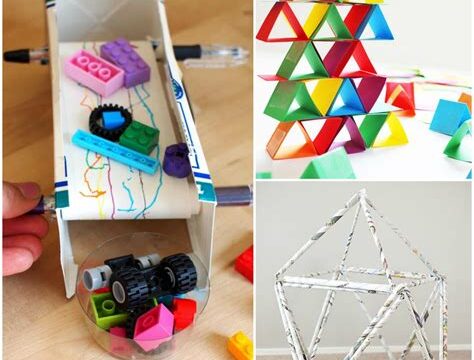Introduction to STEM Education
STEM education has gained significant attention in recent years, and for good reason. As our world becomes increasingly dependent on technology, science, engineering, and mathematics play a crucial role in shaping the future. But what exactly is STEM education? In simple terms, STEM stands for Science, Technology, Engineering, and Mathematics. It is an approach to learning and teaching that integrates these four disciplines to address real-world problems and build essential skills. The key objective of STEM education is to prepare students for the challenges they may face in the modern workforce, where these subjects are in high demand.
One of the primary reasons why STEM activities are important for kids is that they promote critical thinking and problem-solving skills. Through hands-on experiments and collaborative projects, children are encouraged to ask questions, explore different solutions, and think creatively. This not only enhances their ability to tackle complex problems but also fosters a sense of curiosity and a love for learning. Additionally, STEM education helps children develop 21st-century skills such as communication, collaboration, and innovation, which are vital for success in today’s fast-paced world.
Choosing the right STEM activities for kids is crucial for their engagement and learning outcomes. It is essential to provide activities that align with their interests and abilities. The activities should be challenging enough to promote growth and learning but not too overwhelming as to discourage them. Additionally, incorporating a variety of activities can cater to different learning styles and preferences. Some kids may excel in hands-on experiments, while others may prefer coding or building models. By offering a range of options, children can explore their interests and discover their passions within the STEM fields.
Why STEM Activities are Important for Kids
STEM, which stands for Science, Technology, Engineering, and Mathematics, has become a buzzword in education and child development over the past few years. STEM activities aim to expose children to these disciplines in a fun and engaging way. But why are STEM activities so important for kids? Let’s delve deeper and explore the reasons behind the significance of STEM education.
First and foremost, STEM activities help children develop critical thinking and problem-solving skills. When engaging in STEM activities, kids are encouraged to think creatively and use their analytical skills to find innovative solutions. This fosters a sense of curiosity and perseverance, as they learn to tackle challenges and overcome obstacles.
Additionally, STEM activities promote collaboration and teamwork. Many STEM projects require children to work in groups, enabling them to enhance their communication and cooperation skills. By working together, kids learn how to effectively communicate their ideas and listen to others, fostering a collaborative and inclusive environment.
- Enhances creativity: STEM activities allow children to think outside the box and develop their imagination. Through hands-on experiments and projects, they can explore and create new things, nurturing their creative thinking abilities.
- Prepares for the future: In today’s digital age, technology is evolving at a rapid pace. Introducing children to STEM education equips them with the necessary skills and knowledge to thrive in the future job market, which is heavily focused on STEM-related fields.
- Promotes real-world application: STEM activities bridge the gap between theoretical knowledge learned in the classroom and its practical application in real-life situations. Children can directly apply what they have learned to solve practical problems, making the learning experience more meaningful and relevant.
In conclusion, STEM activities are invaluable for children’s educational development. By engaging in these activities, kids can develop critical thinking skills, enhance creativity, improve teamwork abilities, and prepare for the future. The integration of STEM education in early childhood lays a strong foundation for lifelong learning and opens up numerous opportunities for children to excel in various domains. So go ahead and explore the exciting world of STEM activities with your kids!
Choosing the Right STEM Activities for Kids
When it comes to providing an educational and engaging experience for children, STEM activities are a popular choice. STEM, which stands for Science, Technology, Engineering, and Mathematics, encompasses a wide range of activities that promote critical thinking, problem-solving skills, and creativity in children. Choosing the right STEM activities for kids can be a challenging task, as there are countless options available. However, with careful consideration, parents and educators can select activities that align with the child’s interests, age, and learning goals.
One important factor to consider when choosing STEM activities for kids is their age and developmental stage. Younger children may benefit from activities that focus on basic concepts such as color recognition, shapes, and counting. As they grow older, activities involving simple machines, circuits, and coding can be introduced to further stimulate their curiosity and understanding of STEM principles. It is essential to select activities that are appropriate for the child’s developmental level to ensure that they are both challenged and successful in their learning.
Another aspect to consider is the child’s interests and preferences. Children are more likely to engage and participate in activities that align with their interests. For example, if a child has a fascination with space, activities related to rockets, planets, and astronauts may be more appealing to them. On the other hand, if a child has an interest in animals, activities related to biology and animal habitats may capture their attention. By incorporating the child’s interests into the selection of STEM activities, parents and educators can enhance their motivation and enthusiasm for learning.
- Assess the child’s prior knowledge and skills in STEM subjects.
- Consider the availability of resources and materials needed for the activities.
- Consult other parents, educators, or online resources for recommendations.
- Take into account the child’s learning style and preferences.
- Think about the desired learning outcomes and goals for the child.
In addition to considering the child’s age and interests, there are several other factors that can help in choosing the right STEM activities. It is essential to assess the child’s prior knowledge and skills in STEM subjects to ensure that the activities are appropriately challenging and build upon their existing knowledge. Considering the availability of resources and materials needed for the activities is also crucial. Some activities may require specific materials or equipment, which may not be easily accessible. Consulting other parents, educators, or online resources can provide valuable recommendations and insights into suitable STEM activities. Furthermore, taking into account the child’s learning style and preferences can contribute to a more personalized and effective learning experience. Finally, thinking about the desired learning outcomes and goals for the child can help narrow down the options and select activities that align with specific educational objectives.
| Factors to Consider | Examples |
|---|---|
| Age and developmental stage | Younger children: color recognition activities Older children: circuit building projects |
| Interests and preferences | Space-related activities for a child interested in astronomy |
| Prior knowledge and skills | Choosing advanced coding activities for a child with programming experience |
| Availability of resources and materials | Activities requiring common household materials versus specialized equipment |
| Learning style and preferences | Selecting hands-on activities for a kinesthetic learner |
| Desired learning outcomes and goals | Activities focusing on problem-solving skills or creativity |
Hands-on Experiments for STEM Workshops
STEM education is a rapidly growing field that focuses on preparing students for future careers in science, technology, engineering, and mathematics. One crucial component of STEM education is hands-on experiments. These experiments provide students with the opportunity to apply the concepts they have learned in a practical and interactive way.
Hands-on experiments in STEM workshops serve multiple purposes. First and foremost, they engage students in the learning process by allowing them to actively participate in the experiments. This hands-on approach fosters curiosity and a deeper understanding of scientific principles. Students are more likely to retain information when they can see the results of their own experiments and draw conclusions from their observations.
Additionally, hands-on experiments promote critical thinking and problem-solving skills. During these experiments, students are encouraged to think analytically and find innovative solutions to complex problems. They learn how to design experiments, collect and analyze data, and draw logical conclusions. These skills are invaluable in today’s rapidly changing world, where the ability to adapt to new situations and think critically is essential.
Collaborative Projects in STEM Workshops
In today’s world, collaboration and teamwork have become crucial skills in various fields. It is no different when it comes to STEM (Science, Technology, Engineering, and Mathematics) education. Collaborative projects in STEM workshops enable students to work together, pool their ideas, and solve complex problems. This approach not only enhances their technical skills but also fosters critical thinking, communication, and leadership abilities.
Collaborative projects allow students to apply their knowledge and skills in a practical and hands-on manner. They involve working in teams, where each member brings their unique strengths and perspectives to the table. By working together, students learn from one another and develop a deep understanding of the subject matter. Moreover, collaborative projects promote creativity and innovation as students brainstorm ideas and develop innovative solutions to real-world problems.
Using Technology Tools for STEM Learning
Technology has become an integral part of our daily lives, and its impact on education cannot be ignored. In recent years, there has been a growing emphasis on incorporating technology into various fields of education, including STEM (Science, Technology, Engineering, and Mathematics) learning. The use of technology tools in STEM education has revolutionized the way students learn and engage with these subjects.
One of the key advantages of using technology tools for STEM learning is that it enhances the learning experience by making it more interactive and engaging. Whether it’s virtual reality simulations, coding software, or online collaborations, technology tools allow students to actively participate in the learning process. This hands-on approach not only makes the learning process more enjoyable but also helps students develop critical thinking and problem-solving skills.
Furthermore, technology tools provide students with access to a wealth of resources and information, enabling them to explore and learn at their own pace. With the internet and online databases, students can access a vast array of educational materials, videos, and tutorials related to STEM subjects. This not only broadens their knowledge but also exposes them to real-world applications of STEM concepts.
Assessing and Evaluating STEM Workshop Outcomes
When it comes to STEM education, one of the key aspects is assessing and evaluating the outcomes of workshop activities. This step is crucial as it helps educators determine the effectiveness of their teaching methods and identify areas for improvement. Assessing and evaluating STEM workshop outcomes not only provides valuable insights into students’ learning progress but also helps in designing future workshops that are tailored to the specific needs of learners.
One of the common ways to assess STEM workshop outcomes is through the use of formative assessments. These assessments are conducted during the workshop and provide real-time feedback on students’ understanding and progress. Formative assessments can take various forms, such as quizzes, hands-on activities, and group discussions. By actively engaging students in these assessments, educators can gauge their level of comprehension and identify any misconceptions or gaps in knowledge.
Another method for assessing and evaluating STEM workshop outcomes is through summative assessments. Unlike formative assessments, summative assessments are conducted at the end of the workshop to evaluate students’ overall performance and mastery of the concepts taught. This can be done through traditional tests or project-based assessments, where students showcase their understanding through practical application and problem-solving. Summative assessments provide a comprehensive overview of students’ learning outcomes and can be used to measure the effectiveness of the workshop as a whole.
In addition to formative and summative assessments, educators can also gather feedback from students through surveys or interviews. These qualitative assessments allow students to express their thoughts and opinions about the workshop, highlighting their strengths, weaknesses, and areas where they believe they need further support. This feedback can be invaluable in shaping future workshops and tailoring them to meet the specific needs and interests of the students.
Furthermore, using technology tools can greatly enhance the assessment and evaluation process in STEM workshops. Online platforms, educational apps, and interactive software can not only provide innovative ways for students to demonstrate their learning but also make the assessment process more engaging and interactive. For example, virtual simulations and digital portfolios can allow students to showcase their projects and experiments in a dynamic and interactive manner, providing educators with a more holistic view of their learning outcomes.
In conclusion, assessing and evaluating the outcomes of STEM workshops is vital for educators to gauge students’ learning progress and the effectiveness of their teaching methods. By using a combination of formative and summative assessments, gathering qualitative feedback, and incorporating technology tools, educators can gain valuable insights into students’ understanding, identify areas for improvement, and design future workshops that are engaging and impactful.
Frequently Asked Questions
Q: What is the importance of STEM activities for kids?
A: STEM activities are important for kids as they help develop critical thinking, problem-solving, and collaboration skills. They also encourage creativity, curiosity, and a love for learning in subjects like science, technology, engineering, and mathematics.
Q: How do I choose the right STEM activities for my kids?
A: When choosing STEM activities for kids, consider their interests and age appropriateness. Look for activities that are hands-on, engaging, and align with their current knowledge and skills. You can also consider their learning style and preferences to make the experience more enjoyable and effective.
Q: Can you provide some examples of hands-on experiments for STEM workshops?
A: Sure! Some examples of hands-on experiments for STEM workshops include building a volcano using baking soda and vinegar, creating a paper helicopter to explore the principles of flight, or conducting a simple circuit experiment using wires, batteries, and bulbs.
Q: Are collaborative projects important in STEM workshops?
A: Yes, collaborative projects play a crucial role in STEM workshops. They promote teamwork, communication, and problem-solving skills as kids work together to solve a challenge or complete a project. Collaborative projects also mimic the real-world STEM practices where professionals often work in teams to achieve common goals.
Q: How can technology tools enhance STEM learning?
A: Technology tools, such as robotics kits, coding platforms, and virtual simulations, can enhance STEM learning by providing hands-on experiences, allowing kids to apply their knowledge in real-world contexts. These tools also make learning more interactive and engaging, opening up new possibilities for exploring complex concepts.
Q: How can I assess and evaluate the outcomes of a STEM workshop?
A: To assess and evaluate the outcomes of a STEM workshop, you can use various methods such as observations, quizzes, tests, and project presentations. You can also gather feedback from the participants and compare their progress before and after the workshop to measure the impact and effectiveness of the learning experience.
Q: Can you recommend any additional resources for finding STEM activities?
A: Yes, there are several online platforms and resources where you can find STEM activities for kids. Some popular options include educational websites, STEM-focused blogs, YouTube channels, and even dedicated STEM activity books available in both print and digital formats.





